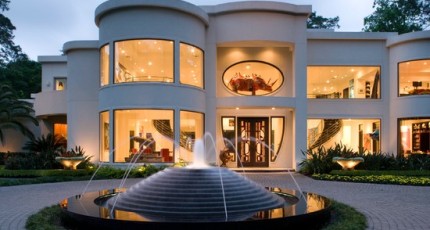Contemporary Landscape

The contemporary landscape attempts to create a mentalist microcosm of the cosmos by presenting a view of the world that everything resides within the mind and proceeds out of it.
Subjective expression is the only guideline to go by, because assumed standards or reality are now held suspect at best, if not rejected outright.
The only sense of absolute becomes the self and the expression of self. This contributes to a feeling that something amorphous is always emerging, taking new form, and changing reality right before our very eyes.
Such ideals are too abstract to be work with unless we give them form in something tangible.
This is why contemporary landscapes rely so heavily on geometric shapes to give solidity to the complex states of consciousness that lie behind their designs. The basic geometric shapes of the universe are altered to create a myriad subset of new forms.
Some of these are created by combining one or more forms with one another. When this is done on a modern landscape, a sense of expansive unity is created. When forms are partitioned, divided, or fragmented, what results is a sense of diminishment, isolation, and redactive focus.
Both techniques are vital to the creation of landscape elements that stand out uniquely as individual forms, yet ultimately work together in harmony with the landscape master plan.
Vegetation is minimal on contemporary landscapes because of the Mentalist preference for human consciousness over the unconscious forces of nature.
There is also another underlying intent to minimizing greenery. Biological life is fleeting and impermanent. Juxtaposed against the forms and frequencies of the universe at large, plant and animal life is only a tiny percentage of what is.
If we look at the human mind, as many do, as a microcosm of space and time, we can immediately see the importance of using only a small amount of plant life on a contemporary landscape. It gives us a glimmer of hope that there is something more to us than the cells of our body, and potential for us beyond the boundaries of what our form prescribes.
Eclectic garden décor further supports this theme by showing how organic life is yet dependant on inorganic materials for is existence.
After all, plants feed off of inorganic minerals, and in turn, they break up rocks and soil through which wind and water flow. This direct relationship between the mineral realm and the biological realm can be emphasized and magnified by all sorts of unique decorations.
Mirrors reflect light, which are part of the process of photosynthesis. Steel, made from iron, helps remind us of the importance of iron in the soil. The shaping of these raw materials into recognizable objects also emphasizes the continual need of the contemporary landscape to revisit the theme of consciousness.
It also reminds us that something common to both the living and non-living substance of our universe is animating its force of constant emergence, flux, and transmutation.
Highly customized water features are key to the full development of this complex and challenging form of landscape design.
You never see anything like a three-level fountain or a cherub with a bubbling water pot. Contemporary fountain design is highly customize in order to shape water into patterns and forms that lend a special significance to the landscape at hand.
You see, water itself is something of a paradox. It is by nature inorganic, yet everything organic depends on water for its existence. By feeding water into the inorganic essence of the contemporary landscape, we create a sense that something beyond the realm of the carbon-based can actually have a kind of life of its own.
Another way of saying it would be that the abstract and geometric comes “to life” in a way that reveals consciousness, not biology, as the true nature of this thing we call life.
Since 1987 Exterior Worlds has specialized in servicing many of Houston’s fine neighborhoods.
Contemporary Patio Design

Contemporary Residential Landscaping

How to Turn Your Yard into an Art Gallery
How a Metal Gazebo Compliments Contemporary Gardens and Art

Contemporary Landscape

